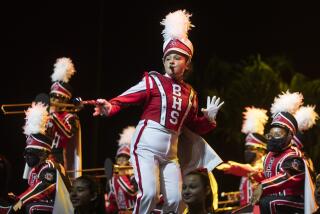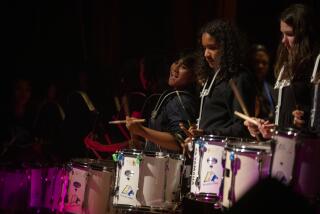GAO Opens Investigation Into Funding of ‘Obscene’ Art
The U.S. General Accounting Office said Friday it had opened an investigation of alleged improper funding of obscene artworks by the National Endowment for the Arts, responding to a demand for a probe earlier this week by Sen. Jesse Helms (R-N.C.).
A GAO official, however, said a preliminary reading of the NEA’s 1990 appropriation bill, which precludes funding of obscene works unless they meet high standards for artistic excellence, appears to give the arts endowment extremely wide leeway.
The GAO, the investigative arm of Congress, was brought into the NEA controversy by Helms when the North Carolina senator asked, in a letter dated March 6 but not made public until this week, for an inquiry into “possible violations of law by the NEA.”
John E. Frohnmayer, the arts endowment’s chairman, said GAO investigators were meeting Friday afternoon in Washington with endowment officials. “I believe we have been very diligent,” he said. “I do welcome the review. If there are things that need to be remedied, I’m the first one that wants to remedy them. But, if not, I hope this impartial review lays the issue to rest.”
Henry Wray, the GAO’s associate general counsel, confirmed the agency is responding to a demand by Helms that it investigate possible violations of restrictive language in the arts endowment’s 1990 funding bill. The rider was inserted as a compromise to resolve an intense controversy last year in which Helms attempted--unsuccessfully--to ban federal funding for any art that was obscene, indecent or even just offensive.
Wray said clear questions exist over whether the restrictive language, which permits funding of any arts project that meets high standards of artistic excellence, has any practical effect on banning federal funding of anything.
“The way the restriction is written leaves the endowment some discretion in what to fund and what not to fund,” Wray said. “It certainly gives them the right to make a judgment. If they make the determination (that a possibly obscene work had exceptional artistic merit), there would be no illegal use of funds.”
A Helms spokesman said the senator would have no statement on the NEA controversy until at least Monday.
The Helms letter included a list of nine specific arts projects that Helms contended were illegal under the terms of the 1990 appropriation law. But while many of the examples were works or shows that had previously been brought into the arts endowment controversy, all nine examples appeared to have been projects funded by the NEA before the current appropriation bill went into effect.
The major elements in Helms’s complaint included “Witnesses: Against Our Vanishing,” an AIDS-related show at a New York City gallery that precipitated a major NEA crisis last November when Frohnmayer first rescinded--then restored--NEA support, and “Modern Primitives,” another 1989 show.
“Modern Primitives” featured body piecing and piercing of the genital organs. It was organized by an arts group in Seattle and exhibited at Southern Exposure, a gallery affiliated with San Francisco’s Project Artaud.
The Helms list also included a 1989 performance by Annie Sprinkle, a controversial New York performance artist, to which conservatives objected.
“I do not question that the endowment’s chairman (Frohnmayer) may be sincere in his assertion that none of the NEA funds are being used to support such ‘art,’ ” Helms said, “but the evidence to the contrary is so compelling that it is imperative that there be an objective investigation.”
More to Read
The biggest entertainment stories
Get our big stories about Hollywood, film, television, music, arts, culture and more right in your inbox as soon as they publish.
You may occasionally receive promotional content from the Los Angeles Times.










